Jun He
ByteDance
UrbanFeel: A Comprehensive Benchmark for Temporal and Perceptual Understanding of City Scenes through Human Perspective
Sep 26, 2025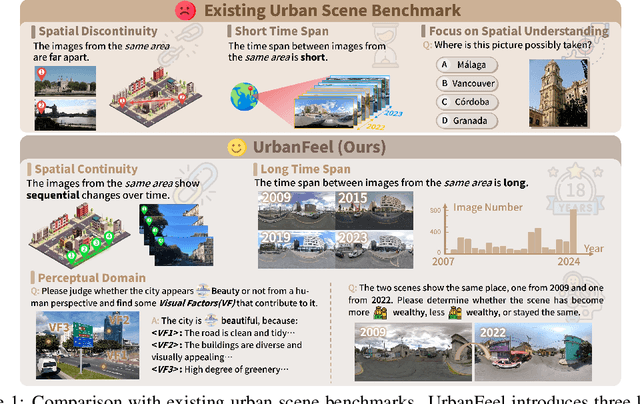
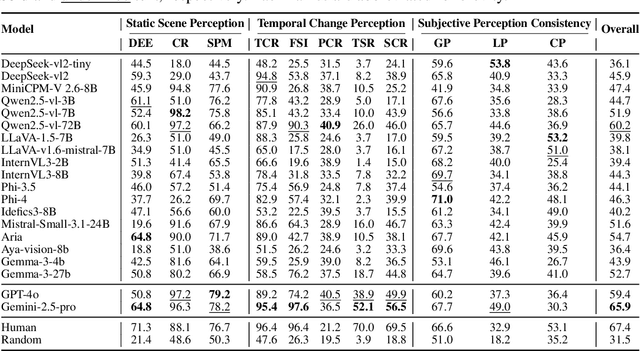
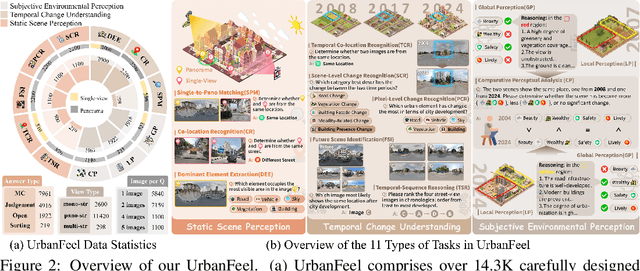
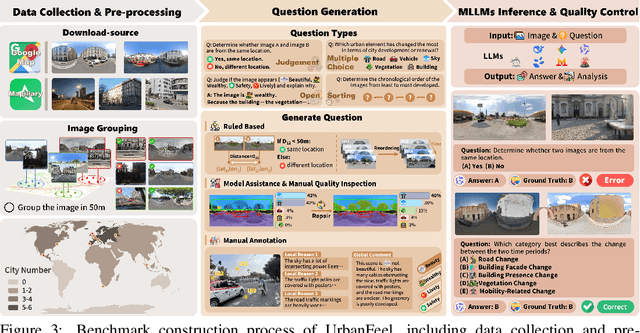
Abstract:Urban development impacts over half of the global population, making human-centered understanding of its structural and perceptual changes essential for sustainable development. While Multimodal Large Language Models (MLLMs) have shown remarkable capabilities across various domains, existing benchmarks that explore their performance in urban environments remain limited, lacking systematic exploration of temporal evolution and subjective perception of urban environment that aligns with human perception. To address these limitations, we propose UrbanFeel, a comprehensive benchmark designed to evaluate the performance of MLLMs in urban development understanding and subjective environmental perception. UrbanFeel comprises 14.3K carefully constructed visual questions spanning three cognitively progressive dimensions: Static Scene Perception, Temporal Change Understanding, and Subjective Environmental Perception. We collect multi-temporal single-view and panoramic street-view images from 11 representative cities worldwide, and generate high-quality question-answer pairs through a hybrid pipeline of spatial clustering, rule-based generation, model-assisted prompting, and manual annotation. Through extensive evaluation of 20 state-of-the-art MLLMs, we observe that Gemini-2.5 Pro achieves the best overall performance, with its accuracy approaching human expert levels and narrowing the average gap to just 1.5\%. Most models perform well on tasks grounded in scene understanding. In particular, some models even surpass human annotators in pixel-level change detection. However, performance drops notably in tasks requiring temporal reasoning over urban development. Additionally, in the subjective perception dimension, several models reach human-level or even higher consistency in evaluating dimension such as beautiful and safety.
Echo-4o: Harnessing the Power of GPT-4o Synthetic Images for Improved Image Generation
Aug 13, 2025Abstract:Recently, GPT-4o has garnered significant attention for its strong performance in image generation, yet open-source models still lag behind. Several studies have explored distilling image data from GPT-4o to enhance open-source models, achieving notable progress. However, a key question remains: given that real-world image datasets already constitute a natural source of high-quality data, why should we use GPT-4o-generated synthetic data? In this work, we identify two key advantages of synthetic images. First, they can complement rare scenarios in real-world datasets, such as surreal fantasy or multi-reference image generation, which frequently occur in user queries. Second, they provide clean and controllable supervision. Real-world data often contains complex background noise and inherent misalignment between text descriptions and image content, whereas synthetic images offer pure backgrounds and long-tailed supervision signals, facilitating more accurate text-to-image alignment. Building on these insights, we introduce Echo-4o-Image, a 180K-scale synthetic dataset generated by GPT-4o, harnessing the power of synthetic image data to address blind spots in real-world coverage. Using this dataset, we fine-tune the unified multimodal generation baseline Bagel to obtain Echo-4o. In addition, we propose two new evaluation benchmarks for a more accurate and challenging assessment of image generation capabilities: GenEval++, which increases instruction complexity to mitigate score saturation, and Imagine-Bench, which focuses on evaluating both the understanding and generation of imaginative content. Echo-4o demonstrates strong performance across standard benchmarks. Moreover, applying Echo-4o-Image to other foundation models (e.g., OmniGen2, BLIP3-o) yields consistent performance gains across multiple metrics, highlighting the datasets strong transferability.
Quantize More, Lose Less: Autoregressive Generation from Residually Quantized Speech Representations
Jul 16, 2025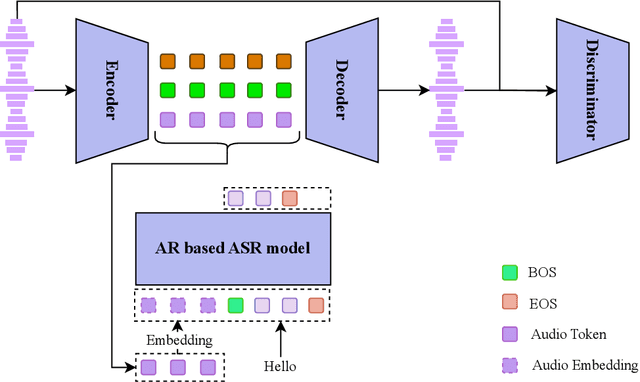



Abstract:Text-to-speech (TTS) synthesis has seen renewed progress under the discrete modeling paradigm. Existing autoregressive approaches often rely on single-codebook representations, which suffer from significant information loss. Even with post-hoc refinement techniques such as flow matching, these methods fail to recover fine-grained details (e.g., prosodic nuances, speaker-specific timbres), especially in challenging scenarios like singing voice or music synthesis. We propose QTTS, a novel TTS framework built upon our new audio codec, QDAC. The core innovation of QDAC lies in its end-to-end training of an ASR-based auto-regressive network with a GAN, which achieves superior semantic feature disentanglement for scalable, near-lossless compression. QTTS models these discrete codes using two innovative strategies: the Hierarchical Parallel architecture, which uses a dual-AR structure to model inter-codebook dependencies for higher-quality synthesis, and the Delay Multihead approach, which employs parallelized prediction with a fixed delay to accelerate inference speed. Our experiments demonstrate that the proposed framework achieves higher synthesis quality and better preserves expressive content compared to baseline. This suggests that scaling up compression via multi-codebook modeling is a promising direction for high-fidelity, general-purpose speech and audio generation.
Estimate Hitting Time by Hitting Probability for Elitist Evolutionary Algorithms
Jun 18, 2025Abstract:Drift analysis is a powerful tool for analyzing the time complexity of evolutionary algorithms. However, it requires manual construction of drift functions to bound hitting time for each specific algorithm and problem. To address this limitation, general linear drift functions were introduced for elitist evolutionary algorithms. But calculating linear bound coefficients effectively remains a problem. This paper proposes a new method called drift analysis of hitting probability to compute these coefficients. Each coefficient is interpreted as a bound on the hitting probability of a fitness level, transforming the task of estimating hitting time into estimating hitting probability. A novel drift analysis method is then developed to estimate hitting probability, where paths are introduced to handle multimodal fitness landscapes. Explicit expressions are constructed to compute hitting probability, significantly simplifying the estimation process. One advantage of the proposed method is its ability to estimate both the lower and upper bounds of hitting time and to compare the performance of two algorithms in terms of hitting time. To demonstrate this application, two algorithms for the knapsack problem, each incorporating feasibility rules and greedy repair respectively, are compared. The analysis indicates that neither constraint handling technique consistently outperforms the other.
SyncTalk++: High-Fidelity and Efficient Synchronized Talking Heads Synthesis Using Gaussian Splatting
Jun 17, 2025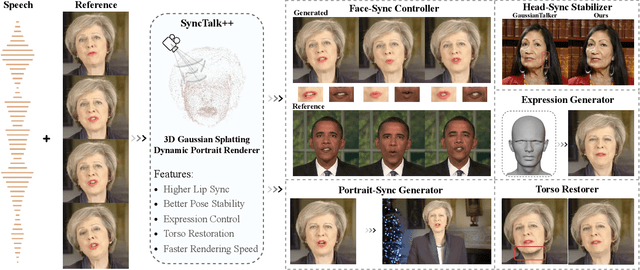
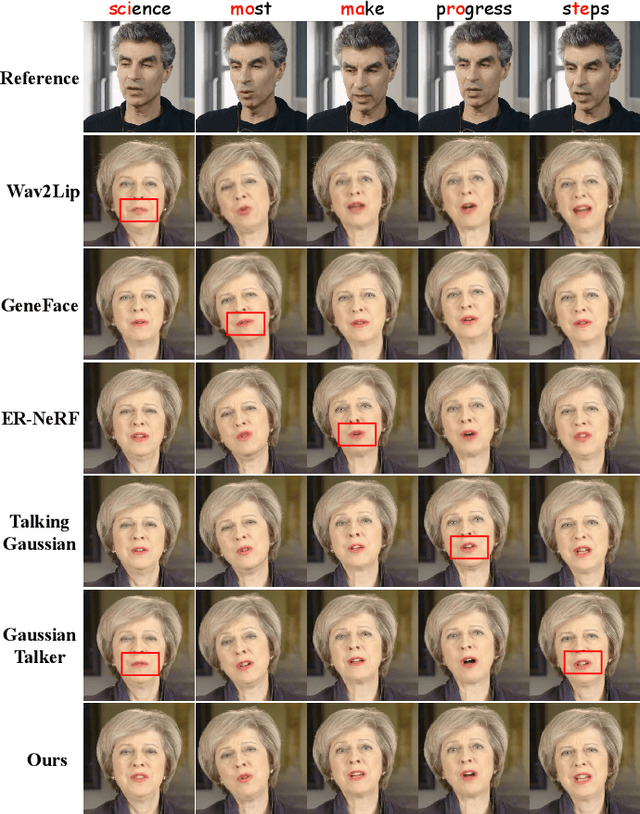

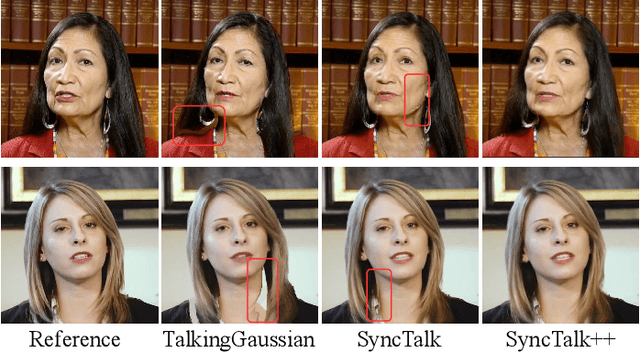
Abstract:Achieving high synchronization in the synthesis of realistic, speech-driven talking head videos presents a significant challenge. A lifelike talking head requires synchronized coordination of subject identity, lip movements, facial expressions, and head poses. The absence of these synchronizations is a fundamental flaw, leading to unrealistic results. To address the critical issue of synchronization, identified as the ''devil'' in creating realistic talking heads, we introduce SyncTalk++, which features a Dynamic Portrait Renderer with Gaussian Splatting to ensure consistent subject identity preservation and a Face-Sync Controller that aligns lip movements with speech while innovatively using a 3D facial blendshape model to reconstruct accurate facial expressions. To ensure natural head movements, we propose a Head-Sync Stabilizer, which optimizes head poses for greater stability. Additionally, SyncTalk++ enhances robustness to out-of-distribution (OOD) audio by incorporating an Expression Generator and a Torso Restorer, which generate speech-matched facial expressions and seamless torso regions. Our approach maintains consistency and continuity in visual details across frames and significantly improves rendering speed and quality, achieving up to 101 frames per second. Extensive experiments and user studies demonstrate that SyncTalk++ outperforms state-of-the-art methods in synchronization and realism. We recommend watching the supplementary video: https://ziqiaopeng.github.io/synctalk++.
OmniSync: Towards Universal Lip Synchronization via Diffusion Transformers
May 27, 2025Abstract:Lip synchronization is the task of aligning a speaker's lip movements in video with corresponding speech audio, and it is essential for creating realistic, expressive video content. However, existing methods often rely on reference frames and masked-frame inpainting, which limit their robustness to identity consistency, pose variations, facial occlusions, and stylized content. In addition, since audio signals provide weaker conditioning than visual cues, lip shape leakage from the original video will affect lip sync quality. In this paper, we present OmniSync, a universal lip synchronization framework for diverse visual scenarios. Our approach introduces a mask-free training paradigm using Diffusion Transformer models for direct frame editing without explicit masks, enabling unlimited-duration inference while maintaining natural facial dynamics and preserving character identity. During inference, we propose a flow-matching-based progressive noise initialization to ensure pose and identity consistency, while allowing precise mouth-region editing. To address the weak conditioning signal of audio, we develop a Dynamic Spatiotemporal Classifier-Free Guidance (DS-CFG) mechanism that adaptively adjusts guidance strength over time and space. We also establish the AIGC-LipSync Benchmark, the first evaluation suite for lip synchronization in diverse AI-generated videos. Extensive experiments demonstrate that OmniSync significantly outperforms prior methods in both visual quality and lip sync accuracy, achieving superior results in both real-world and AI-generated videos.
DualTalk: Dual-Speaker Interaction for 3D Talking Head Conversations
May 26, 2025Abstract:In face-to-face conversations, individuals need to switch between speaking and listening roles seamlessly. Existing 3D talking head generation models focus solely on speaking or listening, neglecting the natural dynamics of interactive conversation, which leads to unnatural interactions and awkward transitions. To address this issue, we propose a new task -- multi-round dual-speaker interaction for 3D talking head generation -- which requires models to handle and generate both speaking and listening behaviors in continuous conversation. To solve this task, we introduce DualTalk, a novel unified framework that integrates the dynamic behaviors of speakers and listeners to simulate realistic and coherent dialogue interactions. This framework not only synthesizes lifelike talking heads when speaking but also generates continuous and vivid non-verbal feedback when listening, effectively capturing the interplay between the roles. We also create a new dataset featuring 50 hours of multi-round conversations with over 1,000 characters, where participants continuously switch between speaking and listening roles. Extensive experiments demonstrate that our method significantly enhances the naturalness and expressiveness of 3D talking heads in dual-speaker conversations. We recommend watching the supplementary video: https://ziqiaopeng.github.io/dualtalk.
MEGADance: Mixture-of-Experts Architecture for Genre-Aware 3D Dance Generation
May 23, 2025Abstract:Music-driven 3D dance generation has attracted increasing attention in recent years, with promising applications in choreography, virtual reality, and creative content creation. Previous research has generated promising realistic dance movement from audio signals. However, traditional methods underutilize genre conditioning, often treating it as auxiliary modifiers rather than core semantic drivers. This oversight compromises music-motion synchronization and disrupts dance genre continuity, particularly during complex rhythmic transitions, thereby leading to visually unsatisfactory effects. To address the challenge, we propose MEGADance, a novel architecture for music-driven 3D dance generation. By decoupling choreographic consistency into dance generality and genre specificity, MEGADance demonstrates significant dance quality and strong genre controllability. It consists of two stages: (1) High-Fidelity Dance Quantization Stage (HFDQ), which encodes dance motions into a latent representation by Finite Scalar Quantization (FSQ) and reconstructs them with kinematic-dynamic constraints, and (2) Genre-Aware Dance Generation Stage (GADG), which maps music into the latent representation by synergistic utilization of Mixture-of-Experts (MoE) mechanism with Mamba-Transformer hybrid backbone. Extensive experiments on the FineDance and AIST++ dataset demonstrate the state-of-the-art performance of MEGADance both qualitatively and quantitatively. Code will be released upon acceptance.
MatchDance: Collaborative Mamba-Transformer Architecture Matching for High-Quality 3D Dance Synthesis
May 21, 2025Abstract:Music-to-dance generation represents a challenging yet pivotal task at the intersection of choreography, virtual reality, and creative content generation. Despite its significance, existing methods face substantial limitation in achieving choreographic consistency. To address the challenge, we propose MatchDance, a novel framework for music-to-dance generation that constructs a latent representation to enhance choreographic consistency. MatchDance employs a two-stage design: (1) a Kinematic-Dynamic-based Quantization Stage (KDQS), which encodes dance motions into a latent representation by Finite Scalar Quantization (FSQ) with kinematic-dynamic constraints and reconstructs them with high fidelity, and (2) a Hybrid Music-to-Dance Generation Stage(HMDGS), which uses a Mamba-Transformer hybrid architecture to map music into the latent representation, followed by the KDQS decoder to generate 3D dance motions. Additionally, a music-dance retrieval framework and comprehensive metrics are introduced for evaluation. Extensive experiments on the FineDance dataset demonstrate state-of-the-art performance. Code will be released upon acceptance.
GPT-ImgEval: A Comprehensive Benchmark for Diagnosing GPT4o in Image Generation
Apr 03, 2025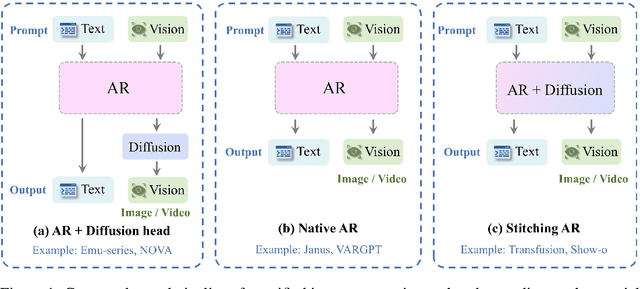
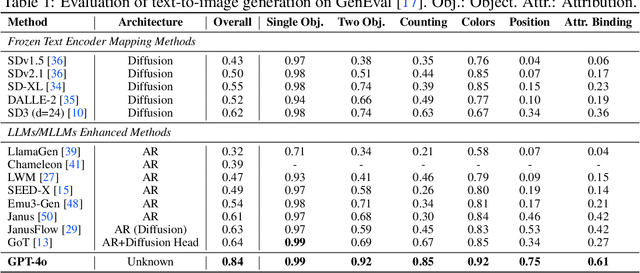
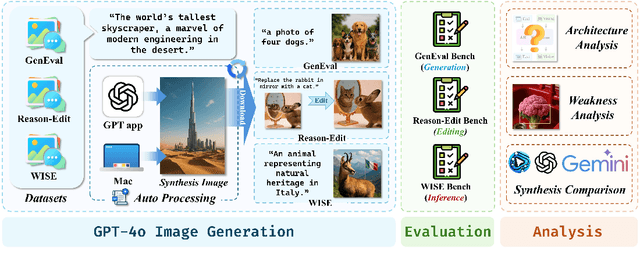
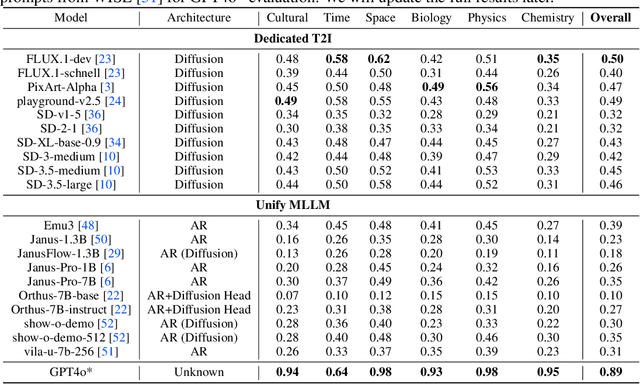
Abstract:The recent breakthroughs in OpenAI's GPT4o model have demonstrated surprisingly good capabilities in image generation and editing, resulting in significant excitement in the community. This technical report presents the first-look evaluation benchmark (named GPT-ImgEval), quantitatively and qualitatively diagnosing GPT-4o's performance across three critical dimensions: (1) generation quality, (2) editing proficiency, and (3) world knowledge-informed semantic synthesis. Across all three tasks, GPT-4o demonstrates strong performance, significantly surpassing existing methods in both image generation control and output quality, while also showcasing exceptional knowledge reasoning capabilities. Furthermore, based on the GPT-4o's generated data, we propose a classification-model-based approach to investigate the underlying architecture of GPT-4o, where our empirical results suggest the model consists of an auto-regressive (AR) combined with a diffusion-based head for image decoding, rather than the VAR-like architectures. We also provide a complete speculation on GPT-4o's overall architecture. In addition, we conduct a series of analyses to identify and visualize GPT-4o's specific limitations and the synthetic artifacts commonly observed in its image generation. We also present a comparative study of multi-round image editing between GPT-4o and Gemini 2.0 Flash, and discuss the safety implications of GPT-4o's outputs, particularly their detectability by existing image forensic models. We hope that our work can offer valuable insight and provide a reliable benchmark to guide future research, foster reproducibility, and accelerate innovation in the field of image generation and beyond. The codes and datasets used for evaluating GPT-4o can be found at https://github.com/PicoTrex/GPT-ImgEval.
 Add to Chrome
Add to Chrome Add to Firefox
Add to Firefox Add to Edge
Add to Edge